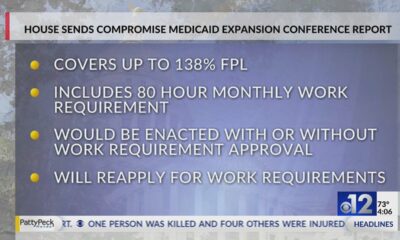Kaiser Health News
When Rogue Brokers Switch People’s ACA Policies, Tax Surprises Can Follow
Julie Appleby, KFF Health News
Mon, 15 Apr 2024 09:00:00 +0000
Tax season is never fun. But some tax filers this year face an added complication: Their returns are being rejected because they failed to provide information about Affordable Care Act coverage they didn't even know they had.
While the concern about unscrupulous brokers enrolling unsuspecting people in ACA coverage has simmered for years, complaints have risen in recent months as consumers discover their health insurance coverage isn't what they thought it was.
Now such unauthorized enrollments are also causing tax headaches. Returns are getting rejected by the IRS and some people will have to pay more in taxes.
“It's definitely gotten worse over the past year. We've helped three to four dozen people this year already,” said Erin Kinard, director of systems and intake for the Health and Economic Opportunity Program at Pisgah Legal Services in North Carolina, which helps low-income families enroll in ACA plans and get tax help.
Neither the IRS nor the Centers for Medicare & Medicaid Services, which oversees the federal Obamacare marketplace, responded to questions about the problem.
The IRS did, however, issue an FAQ in February instructing consumers on what to do if their electronically filed returns are rejected because of ACA issues.
Unauthorized sign-ups can happen in several ways, Kinard and others said. Some rogue agents troll online enrollment portals that are accessible only to brokers but are integrated with the healthcare.gov website. When those agents open a new policy or switch an already enrolled policyholder to a different plan, they garner the associated monthly commissions. Other consumers unwittingly sign up when they respond to advertisements touting gift cards or government subsidies then are transferred to agents who enroll them in health coverage. It's happening even after new rules were put in place requiring agents to get written or recorded consent from clients before making changes.
CMS has not released details on how many consumers have been affected or how many agents have been sanctioned for participating in such schemes.
There's also no public tally of how many taxpayers are facing problems as a result. And the tax consequences can come as a surprise.
“Many people are finding out when they go to e-file their taxes and it bounces back and the IRS says it can't accept your return,” said Christine Speidel, an associate professor and the director of the Federal Tax Clinic at Villanova University's Charles Widger School of Law.
Returns are rejected if the IRS has information indicating the taxpayer has ACA coverage but the returns don't include forms that help determine whether premium tax credits paid on the policyholder's behalf to insurers were correct. If their income was misstated by the rogue broker who enrolled them, for example, they might not have qualified for the full amount paid. Or, if they had affordable employer coverage, they would not have been eligible for ACA subsidies at all.
Ashley Zukoski, an ultrasound technologist in Charlotte, North Carolina, had employer coverage but now faces a tax bill for an ACA plan she said she never signed up for. She reached out to KFF Health News after it reported on such unauthorized plan enrollments.
Unbeknownst to her, she said, a broker in Florida enrolled her family in an ACA plan in late February 2023, even though Zukoski had coverage starting that January through her job. The broker listed an income that qualified the household for a full subsidy, so Zukoski never received a premium bill.
Her first inkling that something was amiss came early in 2024 when she received a special form, called a 1095-A, which showed she had an ACA plan. After reporting the problem to the federal marketplace, she sought to get the 1095-A voided so she would not be liable for the plan's premium subsidies paid by the government to the insurer.
But, because Zukoski's pharmacy had billed the ACA plan instead of her job-based coverage, her request was denied. She plans to appeal.
In the meantime, the family has filed an extension on their taxes.
“Instead of getting a $4,100 refund, we now owe almost $700 in taxes based on the 1095-A and premium tax credit applied,” Zukoski said.
With the April 15 federal tax filing deadline upon us, there are some important steps for affected consumers to take, tax and insurance experts said.
First, because it could take weeks to get corrected forms, experts recommend filing for an extension to buy more time. When consumers file for that extension, they should also pay any taxes owed to avoid penalties and interest.
In general, consumers who at any point in the year think they are victims of an unauthorized enrollment or plan switch should report it immediately to the relevant federal or state ACA marketplace and request a corrected Form 1095-A. But move fast. Appeals to cancel coverage retroactively must be made within 60 days of discovering the fraudulent enrollment, Speidel said.
Consumers can ask for help filing a complaint with federal or state regulators by contacting their own insurance agents or seeking help from assisters or “navigator” programs, which are government-funded nonprofit groups that help people enroll or deal with insurance problems.
Navigators and assisters are fielding many such cases this year and can submit what are called “complex case forms,” which help federal officials investigate such complaints, said Lynn Cowles, program manager for Prosper Health Coverage, a navigator program in Texas.
——————————
By: Julie Appleby, KFF Health News
Title: When Rogue Brokers Switch People's ACA Policies, Tax Surprises Can Follow
Sourced From: kffhealthnews.org/news/article/aca-obamacare-plans-unauthorized-enrollment-tax-problems/
Published Date: Mon, 15 Apr 2024 09:00:00 +0000
Kaiser Health News
What Florida’s New 6-Week Abortion Ban Means for the South, and Traveling Patients
Christopher O'Donnell, Tampa Bay Times
Mon, 29 Apr 2024 09:00:00 +0000
Monica Kelly was thrilled to learn she was expecting her second child.
The Tennessee mother was around 13 weeks pregnant when, according to a lawsuit filed against the state of Tennessee, doctors gave her the devastating news that her baby had Patau syndrome.
The genetic disorder causes serious developmental defects and often results in miscarriage, stillbirth, or death within one year of birth. Continuing her pregnancy, doctors told her, could put her at risk of infection and complications that include high blood pressure, organ failure, and death.
But they said they could not perform an abortion due to a Tennessee law banning most abortions that went into effect two months after the repeal of Roe v. Wade in June 2022, court records show.
So Kelly traveled to a northwestern Florida hospital to get an abortion while about 15 weeks pregnant. She is one of seven women and two doctors suing Tennessee because they say the state's near-total abortion ban imperils the lives of pregnant women.
More than 25,000 women like Kelly traveled to Florida for an abortion over the past five years, state data shows. Most came from states such as Alabama, Louisiana, and Mississippi with little or no access to abortion, data from the Centers for Disease Control and Prevention shows. Hundreds traveled from as far as Texas.
But a recent Florida Supreme Court ruling paved the way for the Sunshine State to enforce a six-week ban beginning in May, effectively leaving women in much of the South with little or no access to abortion clinics. The ban could be short-lived if 60% of Florida voters in November approve a constitutional amendment adding the right to an abortion.
Related Coverage
Conservative Justices Stir Trouble for Republican Politicians on Abortion
In the meantime, nonprofit groups are warning they may not be able to meet the increased demand for help from women from Florida and other Southeastern states to travel for an abortion. They fear women who lack the resources will be forced to carry unwanted pregnancies to term because they cannot afford to travel to states where abortions are more available.
That could include women whose pregnancies, like Kelly's, put them at risk.
“The six-week ban is really a problem not just for Florida but the entire Southeast,” said McKenna Kelley, a board member of the Tampa Bay Abortion Fund. “Florida was the last man standing in the Southeast for abortion access.”
Travel Bans and Stricter Limits
Supporters of the Florida restrictions aren't backing down. Some want even stricter limits. Republican state Rep. Mike Beltran voted for both the 15-week and six-week bans. He said the vast majority of abortions are elective and that those related to medical complications make up a tiny fraction.
State data shows that 95% of abortions last year were either elective or performed due to social or economic reasons. More than 5% were related to issues with either the health of the mother or the fetus.
Beltran said he would support a ban on travel for abortions but knows it would be challenged in the courts. He would support measures that prevent employers from paying for workers to travel for abortions and such costs being tax-deductible, he said.
“I don't think we should make it easier for people to travel for abortion,” he said. “We should put things in to prevent circumvention of the law.”
Both abortion bans were also supported by GOP state lawmaker Joel Rudman. As a physician, Rudman said, he has delivered more than 100 babies and sees nothing in the current law that sacrifices patient safety.
“It is a good commonsense law that provides reasonable exceptions yet respects the sanctity of life for both mother and child,” he said in a text message.
Last year, the first full year that many Southern states had bans in place, more than 7,700 women traveled to Florida for an abortion, an increase of roughly 59% compared with three years ago.
The Tampa Bay Abortion Fund, which is focused on helping local women, found itself assisting an influx of women from Arkansas, Georgia, Mississippi, Louisiana, and other states, Kelley said.
In 2023, it paid out more than $650,000 for appointment costs and over $67,000 in other expenses such as airplane tickets and lodging. Most of those who seek assistance are from low-income families including minorities or disabled people, Kelley said.
“We ask each person, ‘What can you contribute?'” she said. “Some say zero and that's fine.”
Florida's new law will mean her group will have to pivot again. The focus will now be on helping people seeking abortions travel to other states.
But the destinations are farther and more expensive. Most women, she predicted, will head to New York, Illinois, or Washington, D.C. Clinic appointments in those states are often more expensive. The extra travel distance will mean help is needed with hotels and airfare.
North Carolina, which allows abortions through about 12 weeks of pregnancy, may be a slightly cheaper option for some women whose pregnancies are not as far along, she said.
Keeping up with that need is a concern, she said. Donations to the group soared to $755,000 in 2022, which Kelley described as “rage donations” made after the U.S. Supreme Court ended half a century of guaranteeing the federal right to an abortion.
The anger didn't last. Donations in 2023 declined to $272,000, she said.
“We're going to have huge problems on our hands in a few weeks,” she said. “A lot of people who need an abortion are not going to be able to access one. That's really scary and sad.”
Gray Areas Lead to Confusion
The Chicago Abortion Fund is expecting that many women from Southeastern states will head its way.
Illinois offers abortions up until fetal viability — around 24 to 26 weeks. The state five years ago repealed its law requiring parents to be notified when their children seek an abortion.
About 3 in 10 abortions performed in Illinois two years ago — almost 17,000 — involved out-of-state residents, up from fewer than a quarter the previous year, according to state records.
The Chicago nonprofit has prided itself on not turning away requests for help over the past five years, said Qudsiyyah Shariyf, a deputy director. It is adding staffers, including Spanish-language speakers, to cope with an anticipated uptick in calls for help from Southern states. She hopes Florida voters will make the crisis short-lived.
“We're estimating we'll need an additional $100,000 a month to meet that influx of folks from Florida and the South,” she said. “We know it's going to be a really hard eight months until something potentially changes.”
Losing access to abortion, especially among vulnerable groups like pregnant teenagers and women with pregnancy complications, could also increase cases of mental illness such as depression, anxiety, and even post-traumatic stress disorder, said Silvia Kaminsky, a licensed marriage and family therapist in Miami.
related coverage
Can a Fetus Be an Employee? States Are Testing the Boundaries of Personhood After ‘Dobbs'
Kaminsky, who serves as board president of the American Association for Marriage and Family Therapy, said the group has received calls from therapists seeking legal guidance about whether they can help a client who wants to travel for an abortion.
That's especially true in states such as Alabama, Georgia, and Missouri that have passed laws granting “personhood” status to fetuses. Therapists in many states, including Florida, are required to report a client who intends to harm another individual.
“It's creating all these gray areas that we didn't have to deal with before,” Kaminsky said.
Deborah Dorbert of Lakeland, Florida, said that Florida's 15-week abortion limit put her health at risk and that she was forced to carry to term a baby with no chance of survival.
Her unborn child was diagnosed with Potter syndrome in November 2022. An ultrasound taken at 23 weeks of pregnancy showed that the fetus had not developed enough amniotic fluid and that its kidneys were undeveloped.
Doctors told her that her child would not survive outside the womb and that there was a high risk of a stillbirth and, for her, preeclampsia, a pregnancy complication that can result in high blood pressure, organ failure, and death.
One option doctors suggested was a pre-term inducement, essentially an abortion, Dorbert said.
Dorbert and her husband were heartbroken. They decided an abortion was their safest option.
At Lakeland Regional Health, she said, she was told her surgery would have to be approved by the hospital administration and its lawyers since Florida had that year enacted its 15-week abortion restriction.
Florida's abortion law includes an exemption if two physicians certify in writing that a fetus has a fatal fetal abnormality and has not reached viability. But a month elapsed before she got an answer in her case. Her doctor told her the hospital did not feel they could legally perform the procedure and that she would have to carry the baby to term, Dorbert said.
Lakeland Regional Health did not respond to repeated calls and emails seeking comment.
Dorbert's gynecologist had mentioned to her that some women traveled for an abortion. But Dorbert said she could not afford the trip and was concerned she might break the law by going out of state.
At 37 weeks, doctors agreed to induce Dorbert. She checked into Lakeland Regional Hospital in March 2023 and, after a long and painful labor, gave birth to a boy named Milo.
“When he was born, he was blue; he didn't open his eyes; he didn't cry,” she said. “The only sound you heard was him gasping for air every so often.”
She and her husband took turns holding Milo. They read him a book about a mother polar bear who tells her cub she will always love them. They sang Bob Marley and The Wailers' “Three Little Birds” to Milo with its chorus that “every little thing is gonna be alright.”
Milo died in his mother's arms 93 minutes after being born.
One year later, Dorbert is still dealing with the anguish. The grief is still “heavy” some days, she said.
She and her husband have discussed trying for another child, but Florida's abortion laws have made her wary of another pregnancy with complications.
“It makes you angry and frustrated. I could not get the health care I needed and that my doctors advised for me,” she said. “I know I can't go through what I went through again.”
——————————
By: Christopher O'Donnell, Tampa Bay Times
Title: What Florida's New 6-Week Abortion Ban Means for the South, and Traveling Patients
Sourced From: kffhealthnews.org/news/article/florida-6-week-abortion-ban-patient-travel-south/
Published Date: Mon, 29 Apr 2024 09:00:00 +0000
Did you miss our previous article…
https://www.biloxinewsevents.com/exposed-to-agent-orange-at-us-bases-veterans-face-cancer-without-va-compensation/
Kaiser Health News
Exposed to Agent Orange at US Bases, Veterans Face Cancer Without VA Compensation
Hannah Norman, KFF Health News and Patricia Kime
Mon, 29 Apr 2024 09:00:00 +0000
As a young GI at Fort Ord in Monterey County, California, Dean Osborn spent much of his time in the oceanside woodlands, training on soil and guzzling water from streams and aquifers now known to be contaminated with cancer-causing pollutants.
“They were marching the snot out of us,” he said, recalling his year and a half stationed on the base, from 1979 to 1980. He also remembers, not so fondly, the poison oak pervasive across the 28,000-acre installation that closed in 1994. He went on sick call at least three times because of the overwhelmingly itchy rash.
Mounting evidence shows that as far back as the 1950s, in an effort to kill the ubiquitous poison oak and other weeds at the Army base, the military experimented with and sprayed the powerful herbicide combination known colloquially as Agent Orange.
While the U.S. military used the herbicide to defoliate the dense jungles of Vietnam and adjoining countries, it was contaminating the land and waters of coastal California with the same chemicals, according to documents.
The Defense Department has publicly acknowledged that during the Vietnam War era it stored Agent Orange at the Naval Construction Battalion Center in Gulfport, Mississippi, and the former Kelly Air Force Base in Texas, and tested it at Florida's Eglin Air Force Base.
According to the Government Accountability Office, however, the Pentagon's list of sites where herbicides were tested went more than a decade without being updated and lacked specificity. GAO analysts described the list in 2018 as “inaccurate and incomplete.”
Fort Ord was not included. It is among about four dozen bases that the government has excluded but where Pat Elder, an environmental activist, said he has documented the use or storage of Agent Orange.
According to a 1956 article in the journal The Military Engineer, the use of Agent Orange herbicides at Fort Ord led to a “drastic reduction in trainee dermatitis casualties.”
“In training areas, such as Fort Ord, where poison oak has been extremely troublesome to military personnel, a well-organized chemical war has been waged against this woody plant pest,” the article noted.
Other documents, including a report by an Army agronomist as well as documents related to hazardous material cleanups, point to the use of Agent Orange at the sprawling base that 1.5 million service members cycled through from 1917 to 1994.
‘The Most Toxic Chemical'
Agent Orange is a 50-50 mixture of two ingredients, known as 2,4-D and 2,4,5-T. Herbicides with the same chemical structure slightly modified were available off the shelf, sold commercially in massive amounts, and used at practically every base in the U.S., said Gerson Smoger, a lawyer who argued before the Supreme Court for Vietnam veterans to have the right to sue Agent Orange manufacturers. The combo was also used by farmers, forest workers, and other civilians across the country.
The chemical 2,4,5-T contains the dioxin 2,3,7,8-tetrachlorodibenzo-p-dioxin or TCDD, a known carcinogen linked to several cancers, chronic conditions and birth defects. A recent Brown University study tied Agent Orange exposure to brain tissue damage similar to that caused by Alzheimer's. Acknowledging its harm to human health, the Environmental Protection Agency banned the use of 2,4,5-T in the U.S. in 1979. Still, the other weed killer, 2,4-D is sold off-the-shelf today.
“The bottom line is TCDD is the most toxic chemical that man has ever made,” Smoger said.
For years, the Department of Veteran Affairs has provided vets who served in Vietnam disability compensation for diseases considered to be connected to exposure to Agent Orange for military use from 1962 to 1975.
Decades after Osborn's military service, the 68-year-old veteran, who never served in Vietnam, has battled one health crisis after another: a spot on his left lung and kidney, hypothyroidism, and prostate cancer, an illness that has been tied to Agent Orange exposure.
He says many of his old buddies from Fort Ord are sick as well.
“Now we have cancers that we didn't deserve,” Osborn said.
The VA considers prostate cancer a “presumptive condition” for Agent Orange disability compensation, acknowledging that those who served in specific locations were likely exposed and that their illnesses are tied to their military service. The designation expedites affected veterans' claims.
But when Osborn requested his benefits, he was denied. The letter said the cancer was “more likely due to your age,” not military service.
“This didn't happen because of my age. This is happening because we were stationed in the places that were being sprayed and contaminated,” he said.
Studies show that diseases caused by environmental factors can take years to emerge. And to make things more perplexing for veterans stationed at Fort Ord, contamination from other harmful chemicals, like the industrial cleaner trichloroethylene, have been well documented on the former base, landing it on the EPA's Superfund site list in 1990.
“We typically expect to see the effect years down the line,” said Lawrence Liu, a doctor at City of Hope Comprehensive Cancer Center who has studied Agent Orange. “Carcinogens have additive effects.”
In February, the VA proposed a rule that for the first time would allow compensation to veterans for Agent Orange exposure at 17 U.S. bases in a dozen states where the herbicide was tested, used, or stored.
Fort Ord is not on that list either, because the VA's list is based on the Defense Department's 2019 update.
“It's a very tricky question,” Smoger said, emphasizing how widely the herbicides were used both at military bases and by civilians for similar purposes. “On one hand, we were service. We were exposed. On the other hand, why are you different from the people across the road that are privately using it?”
The VA says that it based its proposed rule on information provided by the Defense Department.
“DoD's review found no documentation of herbicide use, testing or storage at Fort Ord. Therefore, VA does not have sufficient evidence to extend a presumption of exposure to herbicides based on service at Fort Ord at this time,” VA press secretary Terrence Hayes said in an email.
The Documentation
Yet environmental activist Elder, with help from toxic and remediation specialist Denise Trabbic-Pointer and former VA physician Kyle Horton, compiled seven documents showing otherwise. They include a journal article, the agronomist report, and cleanup-related documents as recent as 1995 — all pointing to widespread herbicide use and experimentation as well as lasting contamination at the base.
Though the documents do not call the herbicide by its colorful nickname, they routinely cite the combination of 2,4-D and 2,4,5-T. A “hazardous waste minimization assessment” dated 1991 reported 80,000 pounds of herbicides used annually at Fort Ord. It separately lists 2,4,5-T as a product for which “substitutions are necessary to minimize the environmental impacts.”
The poison oak “control program” started in 1951, according to a report by Army agronomist Floyd Otter, four years before the U.S. deepened its involvement in Vietnam. Otter detailed the use of these chemicals alone and in combination with diesel oil or other compounds, at rates generally between “one to two gallons of liquid herbicide” per acre.
“In conclusion, we are fairly well satisfied with the methods,” Otter wrote, noting he was interested in “any way in which costs can be lowered or quicker kill obtained.”
An article published in California Agriculture more than a decade later includes before and after photos showing the effectiveness of chemical brush control used in a live-oak woodland at Fort Ord, again citing both chemicals in Agent Orange. The Defense Department did not respond to questions sent April 10 about the contamination or say when the Army stopped using 2,4,5-T at Fort Ord.
“What's most compelling about Fort Ord is it was actually used for the same purpose it was used for in Vietnam — to kill plants — not just storing it,” said Julie Akey, a former Army linguist who worked at the base in the 1990s and later developed the rare blood cancer multiple myeloma.
Akey, who also worked with Elder, runs a Facebook group and keeps a list of people stationed on the base who later were diagnosed with cancer and other illnesses. So far, she has tallied more than 1,400 former Fort Ord residents who became sick.
Elder's findings have galvanized the group to speak up during a public comment period for the VA's proposed rule. Of 546 comments, 67 are from veterans and others urging the inclusion of Fort Ord. Hundreds of others have written in regarding the use of Agent Orange and other chemicals at their bases.
While the herbicide itself sticks around for only a short time, the contaminant TCDD can linger in sediment for decades, said Kenneth Olson, a professor emeritus of soil science at the University of Illinois Urbana-Champaign.
A 1995 report from the Army's Sacramento Corps of Engineers, which documented chemicals detected in the soil at Fort Ord, found levels of TCDD at 3.5 parts per trillion, more than double the remediation goal at the time of 1.2 ppt. Olson calls the evidence convincing.
“It clearly supports the fact that 2,4,5-T with unknown amounts of dioxin TCDD was applied on the Fort Ord grounds and border fences,” Olson said. “Some military and civilian personnel would have been exposed.”
The Department of Defense has described the Agent Orange used in Vietnam as a “tactical herbicide,” more concentrated than what was commercially available in the U.S. But Olson said his research suggests that even if the grounds maintenance crew used commercial versions of 2,4,5-T, which was available in the federal supply catalog, the soldiers would have been exposed to the dioxin TCDD.
The half dozen veterans who spoke with KFF Health News said they want the military to take responsibility.
The Pentagon did not respond to questions regarding the upkeep of the list or the process for adding locations.
In the meantime, the Agency for Toxic Substances and Disease Registry is studying potential chemical exposure among people who worked and lived on Fort Ord between 1985 and 1994. However, the agency is evaluating drinking water for contaminants such as trichloroethylene and not contamination or pollution from other chemicals such as Agent Orange or those found in firefighting foams.
Other veterans are frustrated by the VA's long process to recognize their illnesses and believe they were sickened by exposure at Fort Ord.
“Until Fort Ord is recognized by the VA as a presumptive site, it's probably going to be a long, difficult struggle to get some kind of compensation,” said Mike Duris, a 72-year-old veteran diagnosed with prostate cancer four years ago who ultimately underwent surgery.
Like so many others, he wonders about the connection to his training at Fort Ord in the early '70s — drinking the contaminated water and marching, crawling, and digging holes in the dirt.
“Often, where there is smoke, there's fire,” Duris said.
——————————
By: Hannah Norman, KFF Health News and Patricia Kime
Title: Exposed to Agent Orange at US Bases, Veterans Face Cancer Without VA Compensation
Sourced From: kffhealthnews.org/news/article/agent-orange-us-bases-veterans-face-cancer-without-va-compensation/
Published Date: Mon, 29 Apr 2024 09:00:00 +0000
Did you miss our previous article…
https://www.biloxinewsevents.com/millions-were-booted-from-medicaid-the-insurers-that-run-it-gained-medicaid-revenue-anyway/
Kaiser Health News
Millions Were Booted From Medicaid. The Insurers That Run It Gained Medicaid Revenue Anyway.
Phil Galewitz, KFF Health News
Fri, 26 Apr 2024 13:55:00 +0000
Private Medicaid health plans lost millions of members in the past year as pandemic protections that prohibited states from dropping anyone from the government program expired.
But despite Medicaid's unwinding, as it's known, at least two of the five largest publicly traded companies selling plans have continued to increase revenue from the program, according to their latest earnings reports.
“It's a very interesting paradox,” said Andy Schneider, a research professor at Georgetown University's McCourt School of Public Policy, of plans' Medicaid revenue increasing despite enrollment drops.
Medicaid, the state-federal health program for low-income and disabled people, is administered by states. But most people enrolled in the program get their health care through insurers contracted by states, including UnitedHealthcare, Centene, and Molina.
The companies persuaded states to pay them more money per Medicaid enrollee under the assumption that younger and healthier people were dropping out — presumably for Obamacare coverage or employer-based health insurance, or because they didn't see the need to get coverage — leaving behind an older and sicker population to cover, their executives have told investors.
Several of the companies reported that states have made midyear and retrospective changes in their payments to plans to account for the worsening health status of members.
In an earnings call with analysts on April 25, Molina Healthcare CEO Joe Zubretsky said 19 states increased their payment rates this year to adjust for sicker Medicaid enrollees. “States have been very responsive,” Zubretsky said. “We couldn't be more pleased with the way our state customers have responded to having rates be commensurate with normal cost trends and trends that have been influenced by the acuity shift.”
Health plans have faced much uncertainty during the Medicaid unwinding, as states began reassessing enrollees' eligibility and dropping those deemed no longer qualified or who lost coverage because of procedural errors. Before the unwinding, plans said they expected the overall risk profile of their members to go up because those remaining in the program would be sicker.
UnitedHealthcare, Centene, and Molina had Medicaid revenue increases ranging from 3% to 18% in 2023, according to KFF. The two other large Medicaid insurers, Elevance and CVS Health, do not break out Medicaid-specific revenue.
The Medicaid enrollment of the five companies collectively declined by about 10% from the end of March 2023 through the end of December 2023, from 44.2 million people to 39.9 million, KFF data shows.
In the first quarter of 2024, UnitedHealth's Medicaid revenue rose to $20.5 billion, up from $18.8 billion in the same quarter of 2023.
Molina on April 24 reported nearly $7.5 billion in Medicaid revenue in the first quarter of 2024, up from $6.3 billion in the same quarter a year earlier.
On April 26, Centene reported that its Medicaid enrollment fell 18.5% to 13.3 million in the first quarter of 2024 compared with the same period a year ago. The company's Medicaid revenue dipped 3% to $22.2 billion.
Unlike UnitedHealthcare, whose Medicaid enrollment fell to 7.7 million in March 2024 from 8.4 million a year prior, Molina's Medicaid enrollment rose in the first quarter of 2024 to 5.1 million from 4.8 million in March 2023. Molina's enrollment jump last year was partly a result of its having bought a Medicaid plan in Wisconsin and gained a new Medicaid contract in Iowa, the company said in its earnings news release.
Molina added 1 million members because states were prohibited from terminating Medicaid coverage during the pandemic. The company has lost 550,000 of those people during the unwinding and expects to lose an additional 50,000 by June.
About 90% of Molina Medicaid members have gone through the redetermination process, Zubretsky said.
The corporate giants also offset the enrollment losses by getting more Medicaid money from states, which they use to pass on higher payments to certain facilities or providers, Schneider said. By holding the money temporarily, the companies can count these “directed payments” as revenue.
Medicaid health plans were big winners during the pandemic after the federal government prohibited states from dropping people from the program, leading to a surge in enrollment to about 93 million Americans.
States made efforts to limit health plans' profits by clawing back some payments above certain thresholds, said Elizabeth Hinton, an associate director at KFF.
But once the prohibition on dropping Medicaid enrollees was lifted last spring, the plans faced uncertainty. It was unclear how many people would lose coverage or when it would happen. Since the unwinding began, more than 20 million people have been dropped from the rolls.
Medicaid enrollees' health care costs were lower during the pandemic, and some states decided to exclude pandemic-era cost data as they considered how to set payment rates for 2024. That provided yet another win for the Medicaid health plans.
Most states are expected to complete their Medicaid unwinding processes this year.
——————————
By: Phil Galewitz, KFF Health News
Title: Millions Were Booted From Medicaid. The Insurers That Run It Gained Medicaid Revenue Anyway.
Sourced From: kffhealthnews.org/news/article/medicaid-unwinding-insurer-revenue/
Published Date: Fri, 26 Apr 2024 13:55:00 +0000
Did you miss our previous article…
https://www.biloxinewsevents.com/california-is-investing-500m-in-therapy-apps-for-youth-advocates-fear-it-wont-pay-off/
-
Local News4 days ago
Sister of Mississippi man who died after police pulled him from car rejects lawsuit settlement
-
Mississippi Today4 days ago
At Lake High School in Scott County, the Un-Team will never be forgotten
-
Mississippi Today1 day ago
On this day in 1951
-
Mississippi News2 days ago
One injured in Mississippi officer-involved shooting after chase
-
Mississippi News7 days ago
Cicadas expected to takeover north Mississippi counties soon
-
Mississippi News6 days ago
Viewers make allegations against Hatley teacher, school district releases statement – Home – WCBI TV
-
Mississippi News Video5 days ago
Vehicle struck and killed man lying in the road, Alcorn County sheriff says
-
Mississippi News4 days ago
Ridgeland man sentenced for molesting girl































